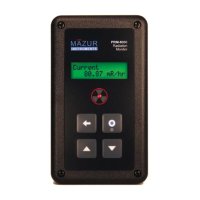PRM-7000 / 8000 / 9000 Users Guide | 29
14.2 Area Measurement and Monitoring
The PRM Instrument is designed to be always-on monitoring the area where it is located.
To assess an area, simply move through the screens (See “4. Home Screen”) of the unit
and view the Average, Minimum and Maximum values. Note the Maximum value mea-
sured as well as the time and date that the Maximum was recorded.
NOTE: Due to the random nature of radioactivity, it is normal to detect a maximum
that is 2X to 3X the normal background radiation. Sustained increases in radiation
will generally be refl ected in an increased Average.
The dose rate alarm can also be set to provide an alarm when the threshold set by the
user is exceeded, See sections “8.3 Alarm On/Off” and “8.4 Setting Alarm Threshold in
mR/hr (mR/hr Alarm)” or “8.5 Setting Alarm Threshold in uSv/hr (uSv/hr Alarm)”.
If an increase in the radiation of the area is suspected, re-establish the background count
taking keen interest to the resulting Average and Maximum values as compared to the
previously established norms for the area.
If increased radiation (indicating prior contamination) is suspected in a particular region
within the area, take timed measurements of the same duration. Compare results with
the normal background and previous measurements to hone in on the source or location
of the highest measurement.
14.3 Measuring Objects
Refer to the following guidelines when measuring an object:
1. With the sensor window or crosshair pointing towards and located
close to the object, slowly scan the object with the PRM Instrument
noting obvious increases in the beep or LED-blink rate.
2. Think of the sensor window or crosshair as a camera lens that is
“looking” at the object. Locating the window farther from the object
increases the area that the PRM Instrument can “see,” but does so at a
greater distance from the potential source of radiation.
NOTE: The user should locate the sensor window or crosshair at a distance from
the object keeping in mind that the strength of a radiation emission decreases as the
square of the distance from the source. For example, if the distance from the source
is doubled, the emission will decrease by a factor of four. If the distance is tripled, the
emission will decrease by a factor of nine. This is known as the inverse square law.

